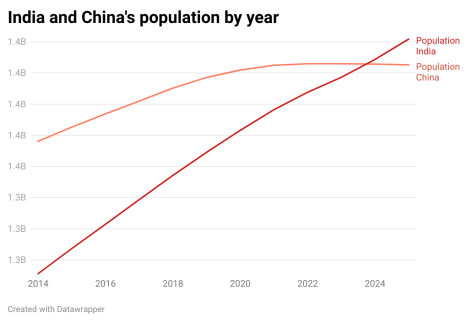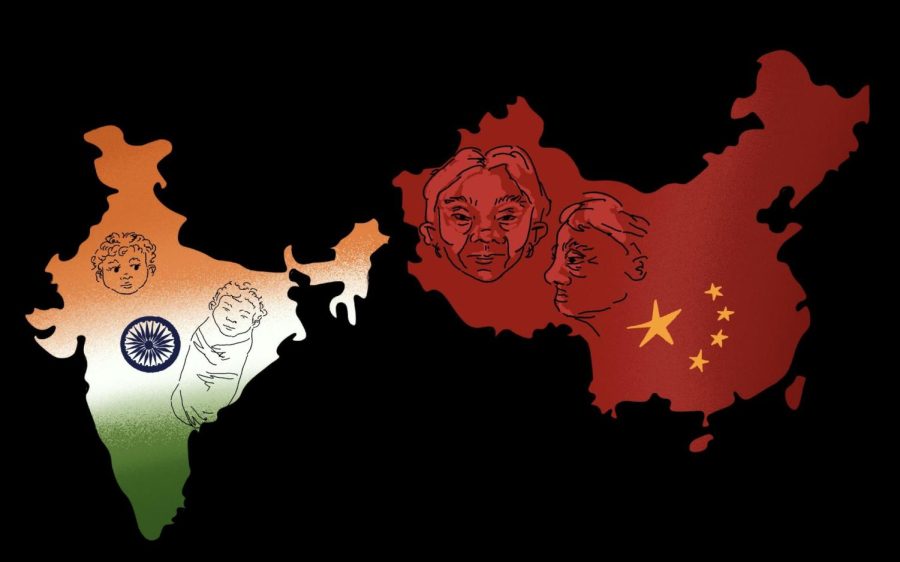Bharat: Soon to be the world’s most populous country
With its population climbing every day, India will usurp China’s position as the most populous country, a position that China held for decades. Comparatively, China’s population has been declining this year as well. The UN proposed that India would surpass China’s population by April 2023. India’s demographic is changing alongside its neighborhooding country due to various factors from within the nation. China’s One-Child Policy, which was only recently abandoned as of 2016, left a lasting impact on the country’s population and economy.
The Hindustani population at 1.210 billion and the Chinese population at 1.345 billion, as of 2011, have both affected the environment within their countries contrastively. With China, a vast majority of its overpopulated demographic consists of an older community and in India, it is quite the opposite. Its immense population consists of young people around the age of 25 according to CNN. These contrasting communities impact the nations differently economically, socially and politically.
What does it mean when media reports tell the public that India’s population is continuously increasing?
“It is not technically exponentially increasing, but rather increasing at a declining rate,” said Dr. Jessica Polos, demographer and professor in public health at DePaul. “There is a demographic phenomenon called population momentum in which a population continues to grow even as the total fertility rate is at or below replacement.”
Many individuals’ immediate thoughts are that overpopulation is bad and inevitable. When looking at the possible solution that was created for China’s dense population, regarding the One-Child Policy, it was negatively viewed worldwide. Several Chinese citizens and others around the world came to see the inferior impacts of this government implemented plan for its nation. This leads people to wonder how this issue could be addressed, if at all, moving forward.
“Having a young population, which is educated of a working age, is a huge boost to the economy of any country. In India’s case, it is also a challenge because the youth are going to need education and health resources,” said Shailja Sharma, professor of Refugee and Forced Migration Studies. “They are currently at a demographic advantage and need to take advantage of it or it could become disastrous for the country.”

The lack of media coverage from government and political figures on the population matter is another factor. Some actions are being implemented upon but are not enough to tackle this issue long-term. With this in mind, the subject being discussed is not communicated to the public and the Indian majority is kept out of the loop.
“India’s government has done some things like privatizing higher education, liberalizing business rules, etc., but that is not enough. More transparency about planning for the ‘youth bulge’ needs to be had,” Sharma said.
Overpopulation can be deemed difficult for this developing nation should issues remain unaddressed.
“Having too many people can lead to scarcity of resources, increased pollution, overcrowding in cities, and a congested job market,” said Ayeshna Desai, University of Southern California Public Health and Human Sciences Graduate. “These are already ongoing issues facing this country. With these factors in mind, it doesn’t leave much room for entry level personnel and younger folk.”
With focus on the younger community, resources given to this demographic directly pertain to the climate of its country, economically.
“In regions like Uttar Pradesh, where educational and job resources are few, we see young people turn to extremist politics and vigilantism. This is the flip side of population growth: a lost generation without adequate education or jobs,” Sharma said.
There are several possible solutions to tackle this issue for this nation, as well as other countries with dense populations. The One-Child Policy was one outcome that did not serve in favor of the Chinese people and their economy long-term. To avoid another situation such as that through a harmful program, the following experts suggested other, more beneficial, suggestions.
Polos shared insight on other types of programs to those who believe overpopulation only has negative implications.
“There has been debate on whether family planning programs should be pushed to reduce family fertility rates,” Polos said. “What needs to be considered in this case, is reproductive justice. What we know is that government control of reproduction has historically led to human rights violations’ as well as problematic demographic patterns.”
What was not heavily considered by the Chinese government was the psychological and physical effects of its policy on the women who had to carry and birth the future generations of China.
“Broad patterns suggest that strong economic development has been associated with fertility declines in India over the last 75 years,” Polos said. “While policies making family planning services accessible to all those who want them are in line with reproductive justice aims, policies that seek to constrain reproductive choice are not.”
The reproductive aspect of overpopulation is one possible outcome. Another answer is aimed towards the financial components for the citizens who wish to have multiple children.
“One potential offering for these people are through financial incentives for those who have less children or those who choose to only have one child. Safe sex practices and increased access to contraceptives are another potential preventative measure,” Desai said.
The above are examples of safeguards to prevent overpopulation, but another way to tackle the problem is to reduce the congestion population of a nation altogether.
“To continue on with this concept of incentives for citizens, rather than punishing them,” Desai said, “giving people financial motives to move out of major cities and into more rural areas not only help to disperse the overall population, but create a plethora of job opportunities as well. This in turn, allows for economic growth, especially when we’re putting emphasis on the younger generations.”
Having a nation in the top spot places social and political awareness on the impact of a growing people, can encourage other nations to reevaluate and reassess this issue entirely.
“If planned carefully, a young population can be advantageous in our current world. India needs to diversify its economy, set up migration or guest worker treaties with aging countries, as well as develop non-metro areas to spread the wealth,” Sharma said. “Overall, this growing population trend won’t last more than twenty years or so. This could be a boom or a bust, depending on how it’s handled.”












